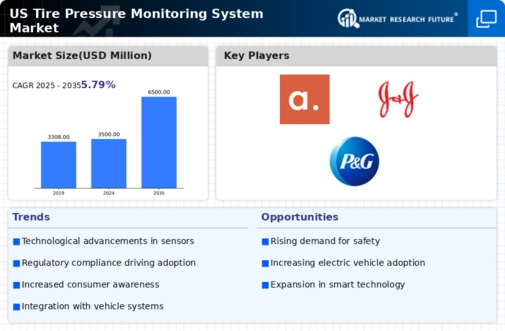Enhanced Safety Standards
Enhanced safety standards significantly influence the tire pressure-monitoring-system market in the automotive sector. Regulatory bodies in the US have established stringent guidelines that require the installation of tire pressure-monitoring systems in new vehicles. For instance, the National Highway Traffic Safety Administration (NHTSA) mandates that all passenger vehicles must be equipped with these systems to ensure optimal tire performance and safety. This regulatory push has led to an increase in the adoption of tire pressure-monitoring systems, as manufacturers strive to comply with safety regulations. As a result, the market is likely to witness sustained growth, driven by the necessity for compliance and the desire to enhance vehicle safety.
Rising Vehicle Production
The tire pressure-monitoring-system market is growing due to increased vehicle production in the US. In 2025, the automotive industry is projected to produce approximately 15 million vehicles, which inherently drives the demand for tire pressure-monitoring systems. As manufacturers seek to enhance vehicle safety and performance, the integration of advanced tire pressure-monitoring systems becomes essential. This trend is further supported by consumer preferences for vehicles equipped with safety features, which are often mandated by regulations. Consequently, the rising vehicle production directly correlates with the expansion of the tire pressure-monitoring-system market, as more vehicles on the road necessitate effective monitoring solutions.
Growing Environmental Concerns
Growing environmental concerns among consumers and regulatory bodies also influence the tire pressure-monitoring-system market. Proper tire maintenance, facilitated by effective monitoring systems, is known to improve fuel efficiency and reduce carbon emissions. In the US, studies indicate that under-inflated tires can lead to a 3% decrease in fuel efficiency, which translates to increased greenhouse gas emissions. As awareness of environmental issues rises, consumers are more inclined to invest in vehicles equipped with tire pressure-monitoring systems that promote sustainability. This shift in consumer behavior is likely to bolster the market, as eco-conscious drivers seek solutions that align with their values.
Technological Integration in Vehicles
The tire pressure-monitoring-system market benefits from ongoing technological integration within vehicles. As automotive technology evolves, manufacturers are increasingly incorporating advanced tire pressure-monitoring systems that offer real-time data and connectivity features. These systems not only monitor tire pressure but also provide alerts and diagnostics, enhancing overall vehicle performance. In 2025, it is estimated that around 60% of new vehicles will feature advanced tire pressure-monitoring systems, reflecting a growing trend towards smart vehicle technologies. This integration is likely to drive market growth, as consumers demand more sophisticated safety and performance features in their vehicles.
Increased Focus on Vehicle Maintenance
An increased focus on vehicle maintenance among consumers is driving growth in the tire pressure-monitoring-system market. As vehicle owners become more aware of the importance of regular maintenance for safety and performance, the demand for tire pressure-monitoring systems is likely to rise. In 2025, it is projected that approximately 40% of vehicle owners will prioritize tire maintenance, leading to a greater emphasis on systems that provide real-time monitoring and alerts. This trend is indicative of a broader shift towards proactive vehicle care, which is expected to drive the tire pressure-monitoring-system market as consumers seek reliable solutions to enhance their driving experience.














Leave a Comment